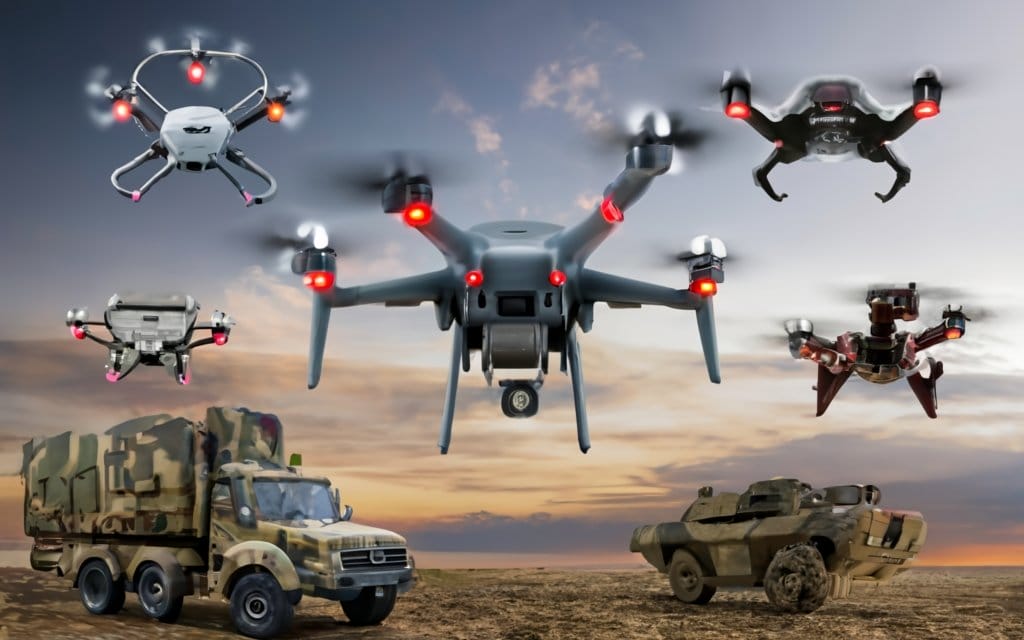What are Drones?
The history of drones, or Unmanned Aerial Vehicles (UAVs), is a fascinating narrative that unfolds at the intersection of aviation and technological innovation. Let’s explore the evolution of these aerial wonders.

Origins of Drones
Drones have existed since the mid-19th century when unmanned balloons filled with explosives were used in conflicts. However, the term “drone” gained prominence in the 1930s when the British developed radio-controlled aircraft for training. In the modern era, drones are called Unmanned Aerial Vehicles (UAVs), which include a vast range of unmanned, remotely piloted aircraft.
Evolution of Drone Technology
The first instances of unmanned aerial technology date back to 1849, when balloons filled with explosives were used. Significant advancements in pilotless aircraft technology occurred from 1915 to 1920 when the military used them. Drone technology has come a long way since its early experiments. Modern drones offer advanced features such as autonomous flight and navigation systems and have diverse applications across various industries.
Types of Drones
Drones, categorized into consumer and professional types, showcase remarkable design and application diversity. Different types of drones cater to distinct purposes for recreational and experienced users.
Consumer Drones
Quadcopters
Notably, quadcopters are popular among consumers for their stable and versatile nature. These types of drones, which have four rotors, offer great control and maneuverability, making them a top choice for hobbyists and enthusiasts.
Hexacopters
Hexacopters are a type of drone that has six rotors instead of the usual four. This design allows them to carry heavier payloads and increases lift capacity, making them ideal for specialized tasks requiring equipment beyond basic flying capabilities. These drones are commonly used in agriculture, search and rescue, and surveying, where their additional lift capacity is essential to complete the task at hand.
Professional Drones
Fixed-wing Drones
Fixed-wing drones are specifically designed for prolonged flights and are highly efficient in surveying large areas and creating detailed maps. With their unique aerodynamic structure, these drones provide efficient and extended aerial coverage, making them an indispensable tool in the agriculture and land surveying industries. Their proficiency in covering expansive areas and generating accurate data has increased their use in various applications, including monitoring crop growth, assessing land topography, and conducting environmental surveys.
Octocopters
Octocopters are a type of professional drone equipped with eight rotors that offer unparalleled stability in flight. Their unique rotor configuration makes them ideal for precision tasks, such as professional photography and cinematography, where stability is crucial for capturing high-quality images and footage. The redundancy in rotor configuration ensures a reliable and smooth flight, even in challenging conditions, making them the preferred choice for professional pilots who demand the highest performance and reliability from their equipment.
Applications of Drones
Drones have found a wide range of applications across various industries. Their versatility and ability to operate in difficult-to-access locations make them highly useful for aerial surveys, search and rescue operations, delivery services, photography and videography, and many more.
Surveillance Drones
Surveillance drones are essential in military and defense applications as they offer unparalleled strategic advantages. These unmanned aerial vehicles monitor and gather intelligence in different operational environments. Surveillance drones have advanced sensors and cameras that enable military users to enhance situational awareness, track potential threats, and conduct reconnaissance missions. Their ability to operate covertly and cover large areas makes them invaluable for military and defense.
Combat Drones
Combat drones, or unmanned combat aerial vehicles (UCAVs), are aircraft designed for military operations that involve offensive and defensive measures. These drones are equipped with weapons to engage targets and execute precise strikes. Using combat drones reduces human personnel risks and enables strategic flexibility in various battle scenarios. They can conduct targeted airstrikes, disrupt enemy communication, and provide air support during military operations. The development and deployment of combat drones represent a paradigm shift in modern military warfare, combining advanced technology with tactical efficiency.
Agriculture and Crop Monitoring
In precision agriculture, drones have become essential tools that significantly monitor crops, evaluate soil health, and optimize farming practices. They provide farmers with real-time data, which enables them to make informed decisions and enhance overall agricultural efficiency.
Aerial Photography and Videography
Drones have disrupted visual storytelling, providing unprecedented perspectives for capturing stunning images and videos. With their agility and maneuverability, drones have redefined the art of photography, from cinematic shots to breathtaking landscapes.
Search and Rescue Operations
Drones are instrumental in search and rescue missions due to their agility and accessibility. They can easily reach otherwise inaccessible areas and provide important information quickly, enhancing rescue operations’ effectiveness. Drones are beneficial in locating missing individuals and assessing regions affected by natural disasters.
Humanitarian Uses of Drones
Drones have been used for various purposes, including military operations, scientific research, and commercial applications. However, drones can also be used for humanitarian and social purposes, providing a low-cost and efficient way to reach needy areas. Using drones in humanitarian efforts is an emerging field, with many organizations exploring this technology’s potential benefits and challenges.
Aerial Assessment
Drones with cameras and sensors can quickly survey disaster-stricken areas, providing real-time imagery and data for damage assessment and resource allocation.
Mapping and Monitoring
Drones create detailed maps of disaster zones, helping humanitarian organizations plan and coordinate their response effectively.
Delivery of Critical Aid
Cargo UAVs are valuable for delivering essential supplies like medical aid, food, water, and shelter to affected areas with damaged infrastructure.
Logistics Support
Drones assist logistics by optimizing supply chain management, ensuring timely and efficient distribution of relief resources.
Transport of Medical Supplies
Drones facilitate the timely delivery of medical supplies, including vaccines, medications, and diagnostic kits, overcoming transport challenges and reducing delays.
Emergency Blood Delivery
Drones enable the swift and reliable transportation of blood and other medical products to healthcare facilities during emergencies.
Increased Accessibility
In regions with limited infrastructure, medical drone deliveries bridge the gap by providing access to critical healthcare resources. Drones also ensure rapid response to medical emergencies, reducing the time it takes to deliver life-saving interventions.
New Era of Drones
The integration of Artificial Intelligence and machine learning algorithms has brought significant advancements in autonomous flight technology, particularly for drones. These developments have ushered in a new era of drones, bringing about greater efficiency and precision in their operations. AI integration and machine learning algorithms have enabled drones to operate beyond pre-programmed instructions with autonomy.
Artificial Intelligence Integration
The integration of AI marks a transformative leap in drone capabilities. AI empowers drones to execute intricate tasks autonomously, making real-time decisions without human intervention. This synergy allows drones to navigate complex environments, adapt to dynamic situations, and perform tasks beyond the scope of traditional programming. Faster processors and enhanced adaptability to diverse environments contribute to the seamless incorporation of AI, revolutionizing the potential applications of drones.
Machine Learning
Machine learning algorithms have a crucial impact on improving the decision-making abilities of drones. These algorithms enable drones to learn from data, adapt to changing situations, and optimize their performance over time. As a result, drones can efficiently navigate and respond to complex scenarios, making them more versatile and practical in various applications, such as surveillance and search and rescue operations.
Urban Air Mobility
Urban Air Mobility (UAM) is a new trend in transportation that aims to use aerial vehicles for urban commuting. UAM is gaining momentum due to traffic congestion and the need for sustainable solutions. Technological advancements, environmental concerns, and the potential to reduce operational costs and carbon footprints are some of the key drivers of UAM growth. The industry has made significant progress, and stakeholders are working towards scaling up the implementation of urban air mobility solutions worldwide.
Swarm Technology
Swarm technology, which involves the coordinated operation of multiple drones, is rapidly emerging as a significant trend with diverse applications. Swarms can range from a few to thousands of drones, working together to perform surveillance and crop monitoring tasks. This technology enables efficient and scalable solutions for various industries. In the military context, autonomous swarm drones are becoming a new face of warfare. Investment in research, development, and deployment of swarm technologies reflects the acknowledgment of their potential in shaping the future of unmanned aerial systems.
Drones Safety Measures
It’s essential to take safety measures seriously while flying drones. Whether you’re a hobbyist or a professional, there are several steps you can take to ensure that you operate your drone safely and responsibly. Some necessary drone safety measures include checking weather conditions before flying, avoiding flying over crowds or near airports, maintaining a clear line of sight with your drone, and always keeping your drone within your control. Drones also come with built-in solutions, like collision avoidance systems and geo-fencing technology, enhancing safety by improving drone operations.
Collision Avoidance System
Drone safety is significantly enhanced through the implementation of Collision Avoidance Systems. These technologies are designed to detect and avoid potential collisions with obstacles, other drones, or manned aircraft. By leveraging sensors, cameras, radar, or lidar systems, drones can detect objects in their path and autonomously adjust their course to prevent accidents. This foresighted approach is crucial for ensuring safe drone operations in various environments, particularly in shared airspace.
Geo-Fencing Technology
Geo-fencing is a pivotal safety measure that employs virtual boundaries to restrict drones from entering specific geographical areas. This technology utilizes GPS, Wi-Fi, or radio frequency signals to create predefined geographical zones. By implementing geo-fencing, operators can establish no-fly zones or restricted areas, enhancing aviation security and preventing drones from entering sensitive locations such as airports, military bases, or crowded public spaces. Geo-fencing is a proactive measure to enhance security, prevent unauthorized drone access, and mitigate potential risks associated with airspace violations.
Environmental Impacts of Drones
Drones are becoming increasingly popular for various purposes, such as photography, surveillance, and delivery. However, their widespread usage has raised concerns about their environmental impact. Drones use lithium polymer batteries, which have a reasonable carbon footprint. The environmental impact of drones is a growing concern and requires attention from manufacturers, users, and regulators alike to minimize their impact on the environment.
Carbon Footprints
Drones, when used for various applications, contribute to the reduction of carbon footprints in comparison to traditional methods. Research indicates that drone technology can significantly lower energy consumption and greenhouse gas (GHG) emissions associated with specific activities, such as package delivery. Studies have shown that drones can reduce energy consumption by up to 94% and GHG emissions by 84% per package delivered, making them an environmentally friendly option for logistics. However, it’s essential to note that the environmental impact can vary based on factors such as the type of drone, payload, and operational conditions.
Sustainable Drone Technology
The integration of drones has significantly impacted the field of sustainability, particularly in data collection and research. With the help of cameras and sensors, drones have become valuable tools for environmental monitoring. This technology allows researchers to assess surface reflectivity and record solar energy absorption in a region. To embrace sustainable drone technologies, utilizing energy-efficient components and eco-friendly materials and optimizing flight paths to minimize environmental impact is crucial. The ongoing development of such technologies aligns with the broader goal of creating a more sustainable and environmentally conscious drone industry.
Cultural Impact of Drones
Drones have had a significant impact on culture in recent years. Drones have revolutionized how we interact with technology and each other, from their use in filmmaking to their integration into military operations and even in our daily lives. Their versatility and maneuverability have made them an invaluable tool in various industries, but they have also sparked debates about privacy and safety concerns. As drones become more accessible and affordable, their cultural impact is likely to continue to grow and evolve in the years to come.
Drones in Film and Art
Drones have completely transformed the film and entertainment industry by offering filmmakers and content creators innovative tools for capturing stunning aerial shots. Using drones in cinematography allows for unique perspectives and dynamic shots that were once difficult or impossible to achieve. This technology has revolutionized the visual storytelling landscape, enhancing the overall cinematic experience for audiences. Drones have become integral to film production, enabling cost-effective aerial footage and creative possibilities in various genres, from action films to documentaries.
Influence on Modern Art
Drones have had a significant impact on modern art installations by enabling the creation of large-scale murals and paintings. Artists can now leverage the capabilities of drones, such as aerial photography and videography, to explore new dimensions of artistic expression. Quadcopters, in particular, have influenced modern art by providing artists with a tool to capture unique perspectives and create immersive installations that engage viewers in innovative ways. This intersection of technology and art showcases the versatility of drones beyond their practical applications, expanding their role in shaping contemporary artistic endeavors.
Drone Industry Market Overview
The drone industry is driven by several key players contributing significantly to its growth and development. Some prominent companies in the drone market include the following:
DJI (Dà-Jiāng Innovations)
DJI is a Chinese technology company known for manufacturing consumer and professional drones. They are widely recognized for their popular drone models and advanced aerial technologies.
Parrot SA
Parrot, a French company, specializes in manufacturing drones for consumer and professional use. They offer a range of products, including consumer drones, professional drones, and drone-related accessories.
AeroVironment, Inc
AeroVironment, based in the United States, focuses on unmanned aircraft systems for various military, commercial, and recreational applications.
Yuneec International
Yuneec, a Chinese drone manufacturer, produces a variety of consumer and professional drones. They are known for their focus on innovation and user-friendly drone designs.
3D Robotics
3D Robotics, based in the United States, specializes in manufacturing drones for industrial applications. They are recognized for providing drone solutions for mapping, surveying, and other professional purposes.
Market Growth and Projection
The drone market has experienced substantial growth, with projections indicating further expansion in the coming years. The global drone market size is estimated to reach USD 260 billion by 2030, with a projected compound annual growth rate (CAGR) of 27% during the forecast period from 2022 to 2030. The drone services market is expected to grow from USD 17.0 billion in 2023 to USD 57.8 billion by 2028, at a CAGR of 27.7%. The global commercial drone market size was estimated at USD 19.89 billion in 2022 and is projected to grow at a CAGR of 13.9% from 2022 to 2030.
Final Thoughts on Drones
Drones have become increasingly versatile and helpful in various sectors, such as surveillance, agriculture, disaster relief, and entertainment. With AI and autonomous capabilities integration, drone technology is evolving rapidly, leading to new and exciting applications. Drones are currently used for various purposes, including power inspection, traffic monitoring, and environmental protection, highlighting their relevance in addressing modern challenges. The ongoing advancements in drone technology, particularly in AI-driven autonomy, are pushing the limits of what drones can achieve, enhancing their impact across industries. This progress is opening up new possibilities for drones, including expanded roles in transportation, delivery services, and further integration into smart cities, which can contribute to increased efficiency and convenience.




Pingback: 10 Best Drones for Kids 2024: Ultimate Buyer's Guide